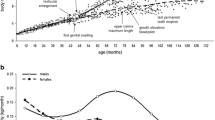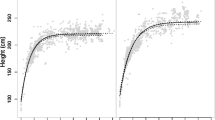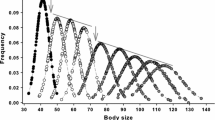Summary
We obtined data on body mass and growth rates for the immature members of two groups of wild baboons in Amboseli National Park, Kenya. Data were collected without feeding, trapping, or handling. The data were separated into cross-sectional and longitudinal components, allowing both the examination of body mass-age relationships and the calculation of growth rates for individuals. For animals less than three years old, body mass was wellperedicted from age by a linear model. Differences based on social group membership were small but consistent, and their origins are discussed. We detected no differences in body mass based on sex or on maternal dominance rank. For older juveniles, those three to seven years of age, a better fit was obtained from log of mass than by mass in a linear model. This was also true for the cross-sectional data set over the whole age range (zero to seven years). For older juveniles, samples were too small for quantitative analysis of differences based on sex, rank, or group membership, but trends in the data are indicated. Growth rates derived from repeat measures of body mass for 38 animals are presented and discussed.
The growth rate values obtained in this study are consistent with data from cross-sectional studies of other wild baboon populations; these values for wild baboons are consistently one-half to one-third lower than growth rate values for well-provisioned captive baboons and equivalent to captive baboons fed a low-protein diet. Comparisons between primates and other mammals in the primate size range raise questions concerning ecological and behavioral constraints on primate growth rates; some possible mechanisms of constraint are suggested.
Similar content being viewed by others
References
Altmann J (1980) Baboon mothers and infants. Harvard University Press, Cambridge, Mass
Altmann J (1983) Costs of reproduction in baboons. In: Aspey WP, Lustick SI (eds) Behavioral energetics: vertebrate costs of survival. Ohio State University Press, Columbus, pp 67–88
Altmann J, Altmann SA, Hausfater G (1981) Physical maturation and age estimates of yellow baboons. Am J Primat 1:389–399
Altmann J, Altmann SA, Hausfater G, McCusky S (1977) Life history of yellow baboons: physical development, reproductive parameters, and infant mortality. Primates 18:315–330
Altmann J, Hausfater G, Altmann SA (1985) Demography of Amboseli baboons 1963–1983. Am J Primat 8:113–125
Altmann J, Hausfater G, Altmann SA (1987) Determinants of reproductive success in savannah baboons. In: Clutton-Brock TH (ed) Reproductive Success. Univ Chicago Press, Chicago (in press)
Bramblett CA (1969) Non-metric skeletal age changes in the Darajani baboon. Am J Phys Anthro 30:161–172
Buss DH, Reed OM (1970) Lactation of baboons fed a low protein maintenance diet. Lab Anim Care 20:709–712
Case TJ (1978) On the evolution and adaptive significance of postnatal growth rates in the terrestrial vertebrates. Quart Rev Biol 53:243–282
Coelho AM Jr (1985) Baboon dimorphism: growth in weight, length and adiposity from birth to eight years of age. In: Watts ES (ed) Nonhuman models for human growth and development. Alan R Liss, Inc, New York, pp 125–159
Eisenberg JF (1981) The mammalian radiations. Univ Chicago Press, Chicago
Gibson KR (1983) Comparative neurobehavioral ontogeny: the constructionist perspective in the evolution of language, object manipulation and the brain. In: DeGrolier E (ed) Glossogenetics. Academic Press, New York, pp 41–66
Glassman DM, Coelho AM Jr, Carey KD, Bramblett CA (1984) Weight growth in savannah baboons: a longitudinal study from birth to adulthood. Growth 48:425–433
Hamilton WJ III, Buskirk RE, Buskirk WH (1978) Omnivory and utilization of food resources by chacma baboons, Papio ursinus. Am Nat 112:911–924
Hausfater G (1975) Dominance and Reproduction in Baboons: A Quantitative Analysis. Karger, Basel
Hausfater G, Altmann J, Altmann S (1982) Long-term consistency of dominance relations among female baboons (Papio cynocephalus). Science 217:752–755
Hayssen VD (1985) A comparison of the reproductive biology of metatherian (marsupial) and eutherian (placental) mammals with special emphasis on sex differences in the behavior of the oppossum, Didelphis virginiana. Ph. D. Thesis, Cornell University, Ithaca
Kerr GR, Allen JR, Scheffler G, Waisman HA (1970) Malnutrition studies in the rhesus monkey, I. Effect on physical growth. Am J Clinical Nutrition 23:739–748
Lack D (1968) Ecological adaptations for breeding in birds. Methuen, London
Mori A (1979) Analysis of population changes by measurement of body weight in the Koshima Troop of Japanese monkeys. Primates 20:371–397
Nicolson N (1982) Weaning and the development of independence in olive baboons. Ph. D. Thesis, Harvard University, Cambridge, Mass
Packer C (1979) Intertroop transfer and inbreeding avoidance in Papio anubis. Anim Behav 27:1–36
Post DG (1982) Feeding behavior of yellow baboons (Papio cynocephalus) in the Amboseli National Park, Kenya. Intl J Primatol 3:403–430
Ricklefs RE (1969) Preliminary models for growth rates of altricial birds. Ecology 50:1031–1039
Riopelle AJ, Shell WF (1978) Protein deprivation in primates: determinants of weight change during and after pregnancy. Am J Clin Nutrit 31:394–400
Sacher GA, Staffeldt EF (1974) Relation of gestation time to brain weight for placental mammals: implications for the theory of vertebrate growth. Am Nat 108:595–615
Sade DS, Cushing P, Dunaif J, Figueroa A, Kaplan J, Lauer C, Rhodes D, Schneider J (1977) Population dynamics in relation to social structure on Cayo Santiago. Yearbook Phys Anthro 20:253–262
SAS Institute Inc (1985) SAS Users Guide: Statistics, Version 5 Edition. SAS Institute Inc, Cary
Sigg H, Stolba A, Abegglen J-J, Dasser V (1982) Life history of hamadryas baboons: physical development, infant mortality, reproductive parameters and family relationships. Primates 23:473–487
Snow CC (1967) The physical growth and development of the open-land baboon, Papio doguera. PhD Thesis, University of Arizona, Tucson
Southwick CH, Richie T, Taylor M, Teas HJ, Siddiqi MF (1980) Rhesus monkey populations in India and Nepal: patterns of growth, decline, and natural regulation. In: Coyen MN, Malpass RS, Klein HG (eds) Biosocial mechanisms of population regulation. Yale University Press, New Haven, Conn, pp 151–170
Stacey PB (1986) Group size and foraging efficiency in yellow baboons. Behav Ecol Sociobiol 18:175–187
Strum SC, Western JD (1982) Variations in fecundity with age and environment in olive baboons (Papio anubis). Am J Primat 3:61–76
Sugiyama Y, Oshawa H (1982) Population dynamics of Japanese monkeys with special reference to the effect of artificial feeding. Folia Primat 39:328–363
Van Wagenen G, Catchpole HR (1956) Physical growth of the rhesus monkey (Macaca mulatta). Am J Phys Anthro 14:245–273
Watts ES (1985) Adolescent growth and development monkeys, apes, and humans. In: Watts ES (ed) Nonhuman primate models for human growth and development. Alan R Liss, New York, pp 41–65
Watts ES, Gavan JA (1982) Postnatal growth and nonhuman primates: the problem of the adolescent spurt. Hum Biol 45:53–70
Western D (1979) Size, life history and ecology in mammals. African J Ecol 20:185–209
Author information
Authors and Affiliations
Rights and permissions
About this article
Cite this article
Altmann, J., Alberts, S. Body mass and growth rates in a wild primate population. Oecologia 72, 15–20 (1987). https://doi.org/10.1007/BF00385038
Received:
Issue Date:
DOI: https://doi.org/10.1007/BF00385038




